Mar 1, 2017 | News
UNESCO Chair Director Alberto García was interviewed in the 20th edition of the Gaceta Conbioética, the magazine of Mexico’s National Commission of Bioethics. García highlights the social dimension of Bioethics, often forget in widespread individualistic approaches. He goes on to explain the history of the Chair and its ongoing mission of fostering the art of convergence and cooperation in global bioethics. García also recalls the Chair’s commitment to the Universal Declaration on Bioethics and Human Rights and the fittingness of its location in Rome, the site of numerous human rights agreements. He concludes with a description of the Chair’s seven main areas of interest, with an extended account of achievements in the areas of Bioethics, Multiculturalism, and Religion, Neurobioethics; and Bioethics Global Art. To read the full interview, please click here.
Nov 17, 2016 | News
by Claudia Sotomayor, Research Scholar of UNESCO Chair in Bioethics and Human Rights
The University of Texas MD Anderson Cancer Center was the host of the Fifth International Bioethics, Multiculturalism, and Religion Workshop and Conference. During three days Bioethical thought leaders from six major religions and ten countries gathered to analyze and discuss the “Bioethical Challenges in Neurogenomics from an Interreligious and Multicultural Perspective.” Previous workshops have successfully taken place in Jerusalem, Rome, Hong Kong and Mexico with the participation of more than 70 prestigious interdisciplinary scholars from around the world.
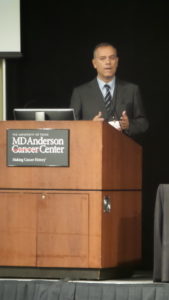
By gathering experts from Buddhism, Christianity, Confucianism, Hinduism, Islam, and Judaism, a rare space for dialogue was created where an atmosphere of friendship and respect reigned. Such dialogue and encounter allowed the participants to analyze the current bioethical issues posted by Neurogenomics, which is presently at a very exciting crossroad since recent discoveries have challenged the classic model of gene organization and information flow, and for these reasons are improving our self-understanding by providing biological descriptions of how man acts. However, the bioethical imperative remains to articulate how man should act within the relevant phenomenological dimensions described from the rich blend of multi-cultural and inter-religious dialogue.
While each session allotted an hour to spontaneous dialogue in response to the three prepared presentations, the conversation inevitably spilled over into the coffee breaks, and shared meals. Each tradition brought up different and unique views that highlighted the importance of this topic. Dr. Alberto Carrara warned that the “reductionist interpretations of neuroscientific results challenge notions of free will, responsibility, personhood and the self which are essential for western culture and society.”
Dr. Ellen Zhang commented that “Buddhism will question scientism that reduces everything to materials while embracing science as a skillful means to help the world to be a better place.” The conversation was enriched by several topics highlighted by the Scholars like the relationship between Neurogenomics and the Islamic Law posted by Dr. Aasim Padela; the resource allocation problem noted by Dr. Mirko Garasic; and the analysis of the human afterlife form a Hinduist perspective explained by Dr. Deepak Sarma. With a great interest the experts expressed their concerns in setting up the limits to protect the dignity of the human person according to their own cultural/religious perspective.
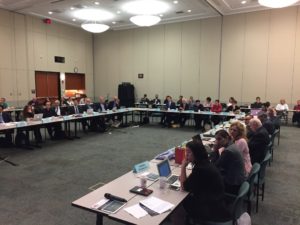
Dr. Ruiping Fan proposed a familial ethical approach highlighting that “Confucianism holds ethical familialism, emphasizing the inherent value of family continuity, integrity, and prosperity, in addition to individual goods” and that “If this Confucian ethical familialism is taken seriously, we should not make individualist ethical guidelines for the research and application of neurogenetics.”
Dr. Leo Goodstadt, professor at Oxford University, explained in detail the human genome during his presentation. There was also an engaging talk on Public Health by Dr. Umair A. Shah, Executive Director Harris County Public Health Houston, Texas. These presentations where open to the public and encouraged participation of the outside community including public authorities, doctors and other healthcare personnel, teachers, university scholars and students. These talks also provided the scientific tools needed to advance the high level ethical reasoning of the Scholars.
Dr. Chris Durante, Professor of Religious Studies at the New York University, set the tone of the various sessions as academic coordinator of this workshop. Following his indications, participants sought to understand each religious tradition and their manner of arriving at moral norms without engaging in ill-informed, harsh criticisms. Without ignoring their obvious ethical differences, emphasis was placed upon finding bridge concepts that could stimulate continued dialogue and practical collaboration in realizing shared values.
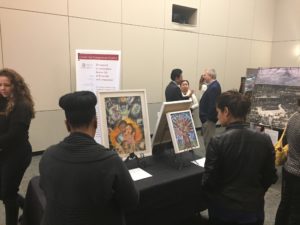
To enlighten not only the mind, but the also the senses, Chair of the Bioethics Art Competition Yvonne Denbina, presented the winning pieces of 2011, 2013, 2015 of the Bioethics Art competition. The images transported the visitors to a deeper understanding of bioethics by the representation of the artists speaking through their images and words, to view the winning pieces visit the website: http://www.bioethicsart.org/. In this site, the information for the 2017 competition titled: A Portrait of Mother Earth and the Challenge of Human Ecology, is available.
The challenging experience of navigating through a complicated and highly technical topic using the lenses of different religious perspectives enabled the participants to share values and attitudes that promoted the dialogue, which fulfilled UNESCO Chair goal of “Fostering the Art of Convergence and Cooperation in Global Ethics.” To continue the international discussion on the various themes raised at the Houston gathering and to prepare for the 2018 workshop and conference, the Fellows participate in the ongoing blog: unescobiochair.wordpress.com, where interested thinkers are welcome to participate and contribute.
Jun 18, 2016 | News
by Dr. Joseph Tham
Members of the UNESCO Chair in Bioethics and Human Rights and the School of Bioethics of the Pontifical Athenaeum Regina Apostolorum participated in the International Association of Bioethics World Congress of Bioethics held in Edinburgh, Scotland June 14-17.
Around 700 delegates from around the world converged to discuss the emerging questions in the field of bioethics. The participants came from many parts of the world and represented many leading bioethics institutions including the Hasting Center, Nuffield Council of Bioethics, and academic institutions such as Harvard, Oxford, Peking, Barcelona, Johns Hopkins, Mayo Clinic, MD Anderson Cancer Center, Tubingen, Manchester, Kyoto, UCLA, National University of Singapore, to name a few.
The UNESCO Chair participated with a presentation of a symposium on “Global Bioethics, Human Rights and Religions.” As the abstract states:
Global bioethics is an emerging concept. In 2005 the UNESCO Universal Declaration on Bioethics and Human Rights was passed by the acclamation of 193 states. In spite of that, some critics argue that ethical relativism is so deeply engrained it prevents the emergence of substantive universal norms, permitting only procedural approaches to shared norms. We question that conclusion. An examination of the notions of rights, duties and dignity in the major religious traditions suggests that there may be paths, through those concepts, to substantive normative convergence. If rights and duties are seen as a unitary thing then their ideological functions will not play such a prominent role in divisiveness among the traditions, but the unified concept(s) could encourage convergence towards norms acceptable to all traditions.
Alberto García, director of the UNESCO Chair spoke on the possibility and challenges of fostering convergence of human rights and duties among different religious traditions. Colleen Gallagher from the Center of Integrated Ethics of the MD Anderson Cancer Center shared with the audience the experience of a global bioethical approach in local health provider environment, where appreciation of cultural and religious diversity can be an important factor of good patient care. Fr. Joseph Tham, Dean of the School of Bioethics, analyzed the contribution of a cross-cultural perspective of natural law that can be supportive of global bioethics. Chris Durante of NYU proposes a methodology of dialogue among diverse ethical positions that are respectful of the religio-cultural differences without yielding to moral relativism.
Yvonne Denbina who heads the Bioethics Art initiative of the UNESCO Chair, also brought and exhibited five pieces of artworks that were winners of the 2015 Bioethics Art Competition. This was in response to the Arts and Ethics section of the IAB conference held in Edinburgh.
After days of hard work and attendance in this conference venue, the team members were also able to spend some time enjoying the artistic treasures, culture, history and culinary specialties of this enchanting city.
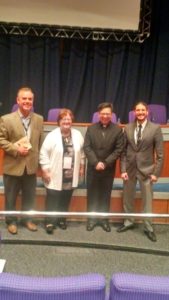
Below are a set of abstracts of the four presentations Chair members presented during the congress:
Convergence of Human Rights and Duties: Towards a Global Bioethics
Prof. Alberto Garcia JD
Director. UNESCO Chair in Bioethics and Human Rights. Rome. Italy
Global bioethics is an emerging concept. In 2005 the UNESCO Universal Declaration on Bioethics and Human Rights was passed by the acclamation of 193 states. In spite of that, some critics argue that ethical relativism is so deeply ingrained it prevents the emergence of substantive universal norms, permitting only procedural approaches to shared norms. We question that conclusion. An examination of the notions of rights, duties and dignity in the major religious traditions suggests that there may be paths, through those concepts, to substantive normative convergence. If rights and duties are seen as a unitary thing then their ideological functions will not play such a prominent role in divisiveness among the traditions, but the unified concept(s) could encourage convergence towards norms acceptable to all traditions.
How Contradictions in the Ius Gentium are reflected in the UNESCO Approach to Bioethics
John Lunstroth, JD
The UNESCO Declaration on Bioethics and Human Rights (2005) purports to be soft international law. It seeks to achieve that status procedurally, through member state consent, and substantively, by numerous references to ius gentium, especially human rights. The ius gentium though consists of several competing normative systems each of which strives to dominate the others. In practice the dominant organizing principle or Aristotelian order (constitution) of the international community is oligarchy. Roughly accommodated within it are several other complex normative orders: science; human rights; humanitarianism; public health; development; and constitutionalism (sovereignty). The positive law of human rights is split at the highest level between the liberalism of the ICCPR and the socialism of the ICESCR. It is thus imprudent to seek soft law status for bioethical norms by wholesale reference to human rights. UNESCO should recognize bioethical norms as subsidiary, and seek to anchor them in specific international rights, e.g. freedom of conscience.
Dialogue despite Diversity: Sharing Norms When Our Moralities Differ
Chris Durante, PhD
Fellow, UNESCO Chair in Bioethics & Human Rights
Visiting Assistant Professor, Religious Studies, Manhattan College
This paper lays the foundations of a bioethical methodology intended to cope with the issues of moral diversity and religio-cultural pluralism without losing site of the fact that bioethics emerged out of the need for shared moral guidelines and rigorous ethical analysis of novel medical technologies. The method being proposed involves a discursive process that is able to quest for consensus while simultaneously maintaining a respect for, and making possible the accommodation of, incommensurable moral and ontological differences amongst religious traditions and philosophical systems and, is intended to contribute new insights into the processes of bioethical inquiry, deliberation and policy formation. Begotten from a diverse array of perspectives, the positions produced by this method have the potential to be more adequately representative of our multicultural and religiously diverse society and hence, can help produce bioethical policies that protect persons from potential harms without overriding their freedom of belief.
Natural Law and Global Bioethics
Fr. Joseph Tham, MD, PhD
Dean, School of Bioethics, Pontificio Ateneo Regina Apostolorum, Rome, Italy
This paper looks at the challenges of ethical behaviors in a global village. Medical tourism, organ trafficking, and gender selective abortions are seen as violations of universal human rights by international standards. Nonetheless, others have questioned whether human rights might not be neo-colonialism in disguise. The natural law tradition analyzed in The Search for Universal Ethics: A New Look at Natural Law seeks to address the perennial problem of universality and particularism in ethics. It proposes rationality as the common ground for human rights and dignity, thus avoiding the simple solution of consensus ethics, without conflating multicultural and multi-religious settings with ethical relativism. The paper will also address the question of the incommensurability of ethical traditions raised by Alasdair MacIntyre. While shunning cultural relativism, he recommends mutual understanding of rival moral traditions through in-depth rational debates and encounters in order to arrive at the most valid moral system.
May 21, 2016 | News
The Coordinator of the Neurobioethics Research Group of Rome and Fellow of the UNESCO Chair Alberto Carrara participated in the Brainforum “Does the brain have a sex?” at Hadrian’s Temple in Rome on May 20. The event was dedicated to sexual difference and the brain. It explored the structural and functional differences between the male and female brain.
Numerous debates regarding the theme proliferate among scientists, academics, sociologists, psychologists, feminists, and other culture sharpers. Professor and Researcher at the Sagol School of Neuroscience at the Tel-Aviv University Daphna Joel opened the round table discussion with her introductory lecture. Joel drew from new developments in cerebral imaging in presenting her innovative “Mosaic Brain” approach.
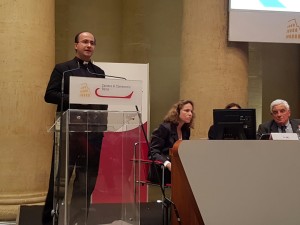
A prestigious panel proceeded to discuss the legal, physiological, genetic, physiological aspects of neuroscientific findings that enrich our understanding of the factors that contribute to behavior.
It is possible to view the stimulating interdisciplinary event online here.
A full list of participants is found below.
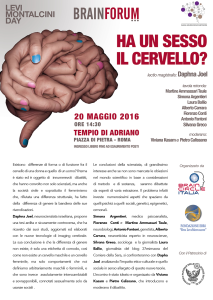
May 19, 2016 | News
In the Ethos Institute feature article “Religion & Violence,” UNESCO Chair Fellow Joseph Tham clarifies the often-misunderstood relationship between religious belief and the violent events that unfortunately fill news outlets. An excerpt from Tham’s article follows. The full text is found here.
We have recently witnessed tragic events of violence in many parts of the world. The massacres in Belgium, Paris, and Pakistan, the shooting in California, the tension in Jerusalem, and the terrorist attacks in Turkey, Egypt, Ivory Coast, and Tunisia are but a few examples. While many of these assaults are attributed to fanatics of Islamic extremism, there is an unspoken thesis that their religious conviction is the seed of such violence. People like Richard Dawkins and Christopher Hitchens would like to brand all religious beliefs under the same banner of intolerance and hate.
…
What is the relationship between religious beliefs and violence? Are monotheistic religions more prone to violence than polytheistic or Asian ones? Does belief in a One True God translate into proselytization and the intolerant suppression all other “false” gods? How do we explain the different passages in the Bible or the Koran that advocate violence towards unbelievers?
Image note: White Crucifixion by Marc Chagall (1938 oil on canvas) depicts Jesus as a Jewish martyr of the Nazi’s horrendous anti-religious persecutions.






